We’re behind again. Darn. Alright, Istanbul…
Basilica Cistern
On our first day there we began a long hike searching for our hotel. Dad punched the address into his ipad and we started off. After a long time (seemed longed because we were carrying our enormous packs) we were very tired. Dad spotted a sign for the hotel, and a few seconds later, Emma spotted the actual place. Which was really lucky, as the ipad told us to keep on going and had the hotel about a mile away. Huh.
After settling down in the small, cramped hotel room, and trying to keep our luggage from spilling over the floor, we headed out for a walk. We hiked around the Blue mosque and Hagia Sofia. I was pushing to get out of the cold and back to the room, but we stopped at the Basilica cistern. We stood in line for a bit, got our tickets, and went down into the Cistern. It was very interesting. Pillars stood in rows, and their bottoms were submerged in the water. Fish swam around, to Emma’s delight. The lighting was dim, creating a cool feel. We walked along the wooden path, looking for the semi-famous Medusa heads that were carved into the base of two pillars. Along the way we noticed this column:
And people were placing their fingers into a hole and twisting their hand. We had no idea what this was, and speculated over it for a bit, and then continued on. Later we discovered that the finger twisting tradition was supposed to bring you good luck. After a long walk through the half submerged field of pillars, we turned left and found the area with the medusa heads. Then, the lights went out. At least for the medusa head section. Only the lucky ones with flashlights could see the heads. Never the less, we whipped out our cameras and took a few pictures with flash.
Now we can see what they look like! They were fairly interesting, but I think the overall aura of the Cistern was what made me like it.
-Bjorn
The Blue Mosque
The blue mosque was my favorite thing in Istanbul. There was a few rues to follow like: All woman have to cover their hair, you must take your shoes off, and no taking pictures while call to prayer. To get in we had to wait in a long line with many other people, At the end of the line there was a large crowd of people taking their shoes off and placing them in plastic bags that the mosque provided. I had a little trouble getting my boots in the plastic bag so I used two bags. All the women had to cover their hair so mommy and I put our scarves on. Once we got inside there was shelves to place our shoes on. The floor was completely carpeted and had many very low metal chandeliers and big pillar that tourists were leaning on. The ceiling was painted with all sorts of blue floral designs. it was really pretty. About half of he mosque maybe less had a tourist fence around it so no tourists could go in. That was for the men to pray. At he back there was a wooden mesh fence where the women pray. In the corner there was a model of the mosque in Mecca. The feel of the mosque made it really cozy. Mom, Bjorn and me sat down for a while and looked at the ceiling while dad stood. Once we were finished looking we left.
-Emma
Aya Sofia
When the vikings saw Istanbul, they called it Mykklegard or “many farms”. This was their idea of a really big town. One of them even carved his name in runes on the second floor banister of the Aya Sofia. “Halfdan was here” or something like that. We spent a long time looking for it and finally had to ask a guard.
The Aya Sofia is now a museum. It was a church for 900 years and then a mosque for another 400 years. We enjoyed exploring the impressive building looking for all the hidden surprises. We found beautiful mosaics on the second floor. On the first floor we found a special pillar that grants wishes if you put your finger in a hole on the side. We also found friendly cats.
-Margit
Istanbul is one of the world’s largest cities, having been the capital of an empire continuously for nearly 1,600 years; first for the Roman Empire, then the Byzantine, the Latin, and finally the Ottoman. It is the only city that has been headquarters for a Christian, and a Muslim empire. It’s history goes back more than 2,600 years, and it has the size and buildings to prove it. Thus, a bus tour of the city to get a feel for the lay of the land seemed in order, the first time on our trip we had decided to do that.
It was, like all of our days in Istanbul, a bit cool, so the double decker bus had the plastic windows down to keep things a bit warmer. This was somewhat disappointing, as the view was impeded, but necessary. The first sight was the Dolmabahce Palace and Mosque. It was a beautiful place, but we decided at the last moment to not get off, as it was closed that day. On our second stop, Taksim Square, we did get off. This is thought to be the heart of modern Istanbul with many reataurants, shops, and hotels. Unfortunately, when we came back an hour later, a group of sixteen, plus multiple others, had purchased tickets. We were able to beg our way on with the promise to stand and to get off at the next stop. The next stop was the Galata Tower, a medevial stone tower built by the Genoese when they were a major power. We intended to hike up to the tower, but ran out of time. By this point, we were concerned about getting back onto the bus, and did not want to risk turning our tour into an all day project. The next bus, fortunately, had plenty of seats, and once on, warm and comfortable, we decided that we would enjoy the rest of the tour uninterrupted. As we continued, the route took us along the Bosphorus Strait, the narrows that connects the Black Sea with the Sea of Marmara (and on to the Mediterranean), and is the dividing point between Europe and Asia. We finished up seeing the old city walls, which, given it’s history were quite extensive, before returning to our starting point at the Hagia Sophia. Home at last, and still, we thought, the most beautiful spot in the city, if not the world.
-Mitch
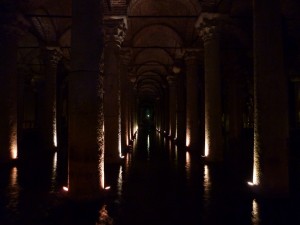
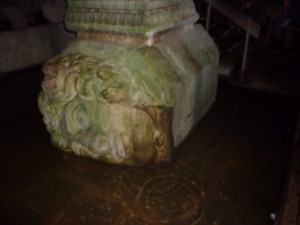
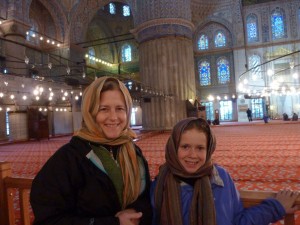
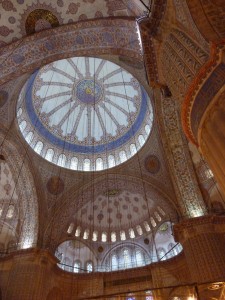
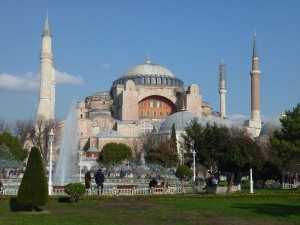
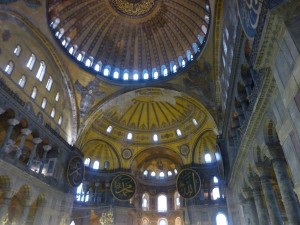
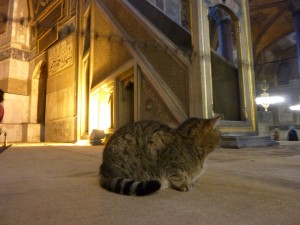
Trackbacks/Pingbacks
https://www.youtube.com/watch?v=5Im2WNyf3mg…
Aunty…